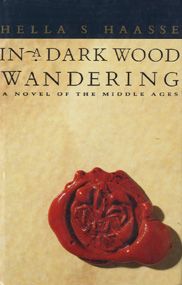This historical novel has its own interesting history. It was written by a Dutch author virtually unknown in the United States, then an English translation was begun by a postal employee who spoke no Dutch. After his death, it was lost for decades in a closet. The final English translation was completed more than 40 years after the novel was written by a Chicago editor who also spoke no Dutch-but who did have the opportunity to get the author's approval.
Charles d'Orleans (1394-1465), shy nephew of mad French king Charles VI, is the focus of this narrative, first published in the Netherlands in 1949. "This massive novel . . . is magisterial in its grasp of princely politics and military maneuvering in the era of the Hundred Years' War between France and England,"
From review on Amazon....
IN A DARK WOOD WANDERING is the story of Charles, Duke of Orleans, grandson of a king, nephew of a king, cousin of the French dauphine saved by Joan of Arc, and father of the man who followed Louis the Spider king to the throne. Most importantly, Charles, Duke of Orleans was a great French poet of the Middle Ages. Some think he is comparable to Dante in Italy or Chaucer in England.
It's easy to become tangled in Louises and Charleses, but here goes: Charles (our hero) had a father, Louis, Duke of Orleans, who was the brother of Charles VI--one of the kings of France during the 100 Years War between England and France. Charles VI was the French king who was bested by Henry V the English king at the battle of Agincourt. When we see Shakespeare's play 'Henry the V' we see the English version of events at Agincourt. Few of us think about the dreadful day from the perspective of the French who saw many of their finest young men killed or captured.
Charles, Duke of Orleans, was captured at Agincourt. Owing to the politics at home (the sympathy of the House of Orleans for the young Dauphin--Charles VI's son), the Duke of Orleans was not ransomed by the Duke of Burgundy, as was the custom in those days, but allowed to languish as a prisoner in England for most of his adult life. Charles younger half-brother continued the Orleans struggle on behalf of the dauphine who would become Charles VII in 1427.
In 1422, when Charles VI died, his young son was prevented from assuming the throne by the Duke of Burgundy. About this time, a young woman had a vision that instructed her to leave her small village and travel to Orleans and help the Dauphin. She persuaded the House of Orleans she could help their cause. Joan the Maid of Orleans bested the English and the Duke of Burgundy, and suceeded in taking the Dauphin to Paris where he was crowned Charles VII. Later, Joan was captured by the English and burned as a witch by the Duke of Burgundy.
While he was a prisoner in England, from 1415 to 1450, Charles, Duke of Orleans was aware of the events back home in France and his family's continued struggles with the Duke of Burgundy. He knew of the association of Jeanne d'Arc and the House of Orleans. As a manifestation of his appreciation of this connection and his growing spirituality, Charles, Duke of Orleans produced some of the most beautiful poetry ever written in French.
In addition to the story of Charles, Duke of Orleans' life, IN A DARK WOOD WANDERING contains excerpts of his beautiful poetry (in French and English). The title of this book refers to the topic of his poetry, the long journey of the soul which until it is united with the object of it's love is lost, in a dark wood, and wandering.
